Geographic Indications and International Trade (GIANT)


1. The Issue
South Korea's domestic apple market has been shielded from international competition
due to the import regulation of the National Plant Quarantine Service and government-led
agricultural market protection in general. Apple cultivation in South Korea
started flourishing after the country's economic development in the 1980s and
the accompanying improvement of dietary life. The increasing demand for apple
as well as the subsidies from the government has benefited the Korean apple
farmers. However, South Korea apple producers will have to face great challenge
from foreign competitors if once WTO's DDA, which seeks trade liberalization
including agricultural sector and market-oriented global economy not disturbed
by tariffs and subsidies, puts into effect. The biggest threat under this circumstance
will be from China which supplies about half the world's apples in the cheapest
prices. In order to deal with the inevitable challenge caused by market opening,
Korean apple producers must improve the quality of their fruits as well as lower
the production cost. In addition, the government should facilitate research
to increase the effectiveness of productivity and management of apple production.
2. Description
 Understanding
the Rational Behind Agricultural Market Protection in South Korea: Trade Liberalization
and Apples
Understanding
the Rational Behind Agricultural Market Protection in South Korea: Trade Liberalization
and Apples
On February 15, 2003 South Korea signed a free trade agreement with Chile after
more than three years of negotiations. On the same day, several thousand members
of a national farmers' organization gathered in Seoul to protest against the
government's signing of the free trade agreement and ask the National Assembly
not to ratify the agreement. These farmers considered themselves as victims
of globalization and asserted that easy access for competitive Chilean agricultural
products would threaten the survival of Korean farmers.
The main concern of them is not the Korea-Chile Free Trade Agreement (FTA)
itself, which excludes a number of Chilean leading export goods such as apples,
pears and rice from the free trade list, in order to minimize damage inflicted
on the Korean agrarian economy. Instead, Korean farmers have worried about the
possibility that FTA will become a watershed to facilitate additional free trade
agreement with other countries, which would expand liberalization into Korea's
major agricultural products.
The agricultural system of Republic of Korea has been based on small, labor
intensive and owner-operated farms. Therefore, Korean farmers are considered
to be vulnerable to agricultural market opening to global trade led by large-scale
cultivators equipped with cutting edge technology and marketing strategy as
well as competitive prices for their agricultural products. The influence of
the Confucian tradition on the Korean culture which views agriculture as the
"most worthy human pursuit" [The Korean, p.194] has made
the Korean public sympathize with the plight of farmers thus led the public
to either support or passively accept the action of the farmers who enthusiastically
advocate the country's agricultural market protection.
 Background
of ROK's Apple Farming
Background
of ROK's Apple Farming
The Balkans are thought to be the original home of the apple tree. The excavation
of charred apples, found in Switzerland's prehistoric dwelling of 20th century
B.C., has led to an estimate of over 4,000 years of history of apples [JAFI].
Korea's first record about apples can be found in the history of Koryo Dynasty
around 1103 A.D. However, apples were considered as rare dietary goods available
mostly to the royal families and upper class Koreans called Yangban until
1906 when the Korean government started investing in apple cultivation. The
Japanese colonization of the Korean Peninsular until the 1945 and the subsequent
outbreak of the Korean War, lasted until 1953, impeded the development of apple
farming in Korea. By the end of the Korean war, ROK suffered from the mass starvation
due to the war-torn environment that devastated most of the agrarian lands thus
even the production of the staple crop could not meet the country's food self-sufficency.
Therefore, apples have not been widely consumed among the general public until
recently.
Rice, the staple food of Korea, has always been the main crop that occupies
more than 50% of the total farmland. However, the country's rapid increase of
GNP and the improvement of dietary life, especially since the 1980s, have boosted
the demands of fruit consumption among the general public in Republic of Korea,
and thus expanded the agricultural land for the output of fruits. The increase
of apple production has been one of the most noticeable development that once
expanded up to 53,000 ha of cultivating land in 1992 (see Table 1).
Table 1. South Korea :Agricultural Land
of Apple Productions (by year)
|
|
1990
|
1992
|
1994
|
1996
|
1998
|
2000
|
2001
|
|
Size of Land (1000 ha)
|
48.8
|
53.0
|
52.1
|
43.9
|
34.7
|
29.1
|
26.3
|
source: Gilan Agricultural Cooperative Association
The agricultural land for apple production has been diminished particularly
since the late 1990s when the country strived to recover from the Asian economic
turmoil. Consequently the economic crisis has frozen the expenditure of most
South Korean households and the demand for apple consumption, which is not a
must-have staple like rice, started dropping accordingly. In addition, cultivating
apples generate relatively less income compare to other fruits such as pears
and grapes. Therefore, many apple farm lands have been either closed or replaced
by farming of other fruits or crops that generate higher profits. It is expected
that the country's agricultural land for apple production will be decreased
further in coming years unless the profits of apple farming increase as high
as the level of income from cultivating other agricultural items. [GACA]
 ROK's Efforts
for International Cooperation and Its Relevance to Korean Agriculture
ROK's Efforts
for International Cooperation and Its Relevance to Korean Agriculture
Due to its strategic importance (see a map of Northeast Asia),
Korea has experienced a gloomy history. It was invaded by other countries about
800 times. In 1592, for example, Japanese leader Toyotomi Hideyoshi invaded
Korea to make the country as a foothold of Japan's expansion of the Asian continent.
The Russo-Japanese War in 1904-1905 was fought over the right to control the
Korean Peninsular between the two major regional powers. Because of the country's
unique history, Korea followed the close door policy and shunned foreign trade
and investment at the end of 19th century and early 20th century. However, the
growing global trend of economic integration and the proliferation of building
regional blocs have influenced South Korea to shed its traditional isolation
in order to join the mainstream of international cooperation [Korean Herald].
Beginning in the early 1960s, South Korea pursued an economic plan that would
soon generate extraordinarily rapid industrialization. The government's export-oriented
growth strategy facilitated the development of manufacturing industry which
saved the country from being one of the poorest countries in the world. By the
mid-1990s, South Korea joined Hong Kong, Singapore and Taiwan as the most promising
industrial powers in the region and became one of the "Asian Four Tigers."
South Korea has entered GATT in 1967 and became one of the countries benefited
the most under the system of liberal trade. For example, South Korean light
industries as well as heavy industries have rapidly developed since the late
1960s as the country started strengthening its capitalist system and stepped
into the global market. The economic development during this time has been an
engine for the South Korean Economic Miracle. Since then, South Korea
has been actively participating in the liberalization efforts led by GATT/WTO.
However, the country has faced the domestic challenges especially against agricultural
market liberalization after WTO's Uruguay Round (UR) negotiations, which have
included negotiations on agriculture for the first time. The country has continued
to join WTO's 9th Round, Doha Development Agenda (DDA) that covers trade liberalization
of every sector including agriculture, industrial products, and service.
However, DDA as well as Uruguay Round has created considerable concerns and
resistance among Korean farmers over the issue of opening agricultural market
that is the most sensitive industrial sector in the country. Traditionally,
Koreans have considered agriculture not just a mere industry but "the root"
of all industries within which the country hold on to its sovereignty [Free
Trade Agreement: Chile and Korea]. Koreans have long believed that once
the country loses a capacity for self-sufficiency of food, its sovereignty would
be more easily controlled by others that could make influence on Korea with
their leverage of food supply. For this reason, Korean government has protected
the country's agriculture and the public has supported this action. Korean farmers
have been protected under the dual price system also known as producer subsidies
with which the government buys agricultural products from farmers at higher
prices and sells these at lower prices to consumers.
Despite these efforts, the country's increasing urbanization and rapid industrialization
have gradually reduced the number of families engaged in agriculture and resulted
in the distortion of the structure of the rural population. For example, South
Korea's agriculture occupied 40% of the country's GDP and 40% of employment
in 1965 but the numbers dramatically dropped to 3.7% of GDP and 8.3% of total
South Korean employment in 2001. Another problem is the aging population of
Korean farmers; in 1999, 33% of rural population was over 60 years old while
14.8% of the country's total population was over 60 years old. In addition,
more than 50% of families dependent on agriculture do not have successors who
are willing to continue farming business [Ministry of Foreign Affairs and
Trade, ROK]. These phenomena have been fueled by income disparity between
the relatively less profitable agricultural sector and other industrial sectors
such as service, manufacturing, and finance, etc. The number of South Korean
farmers are expected to decline further if South Korea, as a member of WTO,
reduces the producer subsidies as well as tariffs on agricultural goods by 2004
under the UR agreement.
 Impact on
Korean Apple
Impact on
Korean Apple
Based on the Doha Declaration, WTO member countries were supposed to conclude
modalities of agricultural tariffs and subsidies by the end of March 2003. The
General Council Chairman Stuart Harbinson has recently suggested that the WTO
member countries have failed to reach an agreement on modalities at the conference
held in Geneva during late March 2003. However, the purpose of the Doha Declaration,
which is the substantial reduction of tariffs and subsidies on agricultural
goods, remains the same although there may be differences on the degree. It
thus appears that South Korea as a WTO member, won't be exempted from the obligation
to further reduce tariffs and subsidies on agricultural products once WTO members
reach an agreement on modalities at any time soon.
Therefore, even if Korean apple markets have been saved from the fierce competition
of Chile's high quality apples thanks to the Korean government's decision to
exclude apples from the FTA with Chile, Korean apple producers won't be able
to avoid a challenge imposed by WTO's Doha agreement which will mandate not
only to open South Korean apple market but also reduce producer subsidies for
apple farming. Once this happens, China will be emerged as the greatest threat
to South Korean apple producers. China is the largest apple producer in the
world (see Table 2).
Table 2. Top 10 Apple Producer (1999)
|
Country
|
Ranking
|
Output (1000mt)
|
|
China
|
1
|
17,508
|
|
USA
|
2
|
4,964
|
|
France
|
3
|
2,500
|
|
Turkey
|
3
|
2,500
|
|
Germany
|
5
|
2,154
|
|
Italy
|
6
|
2,115
|
|
Iran
|
7
|
2,000
|
|
Poland
|
8
|
1,687
|
|
Argentina
|
9
|
1,347
|
|
India
|
10
|
1300
|
source: Chungju Apple Research Institute
(Chungju, South Korea)
China's apple boom was initiated by the Beijing government in the 1980s as
the country started opening its agriculture to the external market. The Chinese
government has tried to improve the productivity as well as the quality of apples
for the last two decades and the country is now producing about half the world's
supply of apples [New York Times].Korean apples are superior to Chinese
apples in terms of quality including fruit size, shape, and saccharinity. However,
newly export-minded Chinese apple producers with the help of the Beijing government
have put efforts to develop new techniques to further improve the quality of
Chinese apples which have been listed as one of the 11 government-designated
commodities that would receive aggressive development support for the next five
years. In addition, thanks to China's low labor and land cost, the Chinese domestic
apple price is 1/4 to 1/5 of Korean domestic apple price and the export price
of Chinese apples are expected to be less than half the price of South Korea's
domestic apple price [GACA].
Chinese apples are currently banned by South Korea's National Quarantine Service.
However, Korea will have to allow market access to Chinese apple producers sooner
of later under WTO conditions. Therefore, the best way for South Korean apple
producers to compete against cheap Chinese apple is to further develop agricultural
technology to increase the quality of Korean apples while reducing the cost
of apple production. In addition, Korean apple farmers may increase the demand
of domestic apple consumption by introducing new foods made of apples (see the
VI section #25, Culture).
3. Related Cases
Keyword Cluster
(1) Trade Product= Apple
(2) Bio-geography= Temperate
(3) Environmental Problem= Habitat Loss
4. Author and Date: Jihyun Kim (April 2003)

5. Discourse and Status: Agreement and Incomplete
Under WTO's Doha Round, the negotiations to establish modalities for the reductions
of agricultural tariffs and subsidies have been in process since March 2002.
The modalities were scheduled to be completed by the end of March 2003. However,
the disputes between exporters and importers of agricultural products have prevented
the negotiation to be signed by the scheduled time. While countries that export
agricultural goods ask for radical reforms of reductions on tariffs and subsidies,
agricultural importers including South Korea advocate the necessity of gradual
and flexible reforms on which each country's agricultural condition is reflected.
6. Forum and Scope: WTO and Multilateral
7. Decision Breadth: 146 member states of WTO (April
2003)
8. Legal Standing: Treaty
The trade barrier of agricultural products has been relatively high compare
to industrial goods, which have been subjects to tariffs reduction since the
beginning of the General Agreement on Tariffs and Trade (GATT). WTO has started
negotiations on agriculture for the first time at the Uruguay Round (UR). Based
on the agreement, members of WTO including South Korea are supposed to reduce
tariffs and subsidies on agricultural products by 2004.
In addition to the UR negotiation on agriculture, the Doha Ministerial Conference,
held in November 2001, has introduced Doha Development Agenda (DDA). The Doha
"declaration reconfirm[ed] the long-term objective already agreed in the
present WTO Agreement: to establish a fair and market-oriented trading system
through a program of fundamental reform" and presented a timetable of "the
single undertaking in which virtually all the linked negotiations are to end
by 1 January 2005" [WTO].

9. Geographic Locations
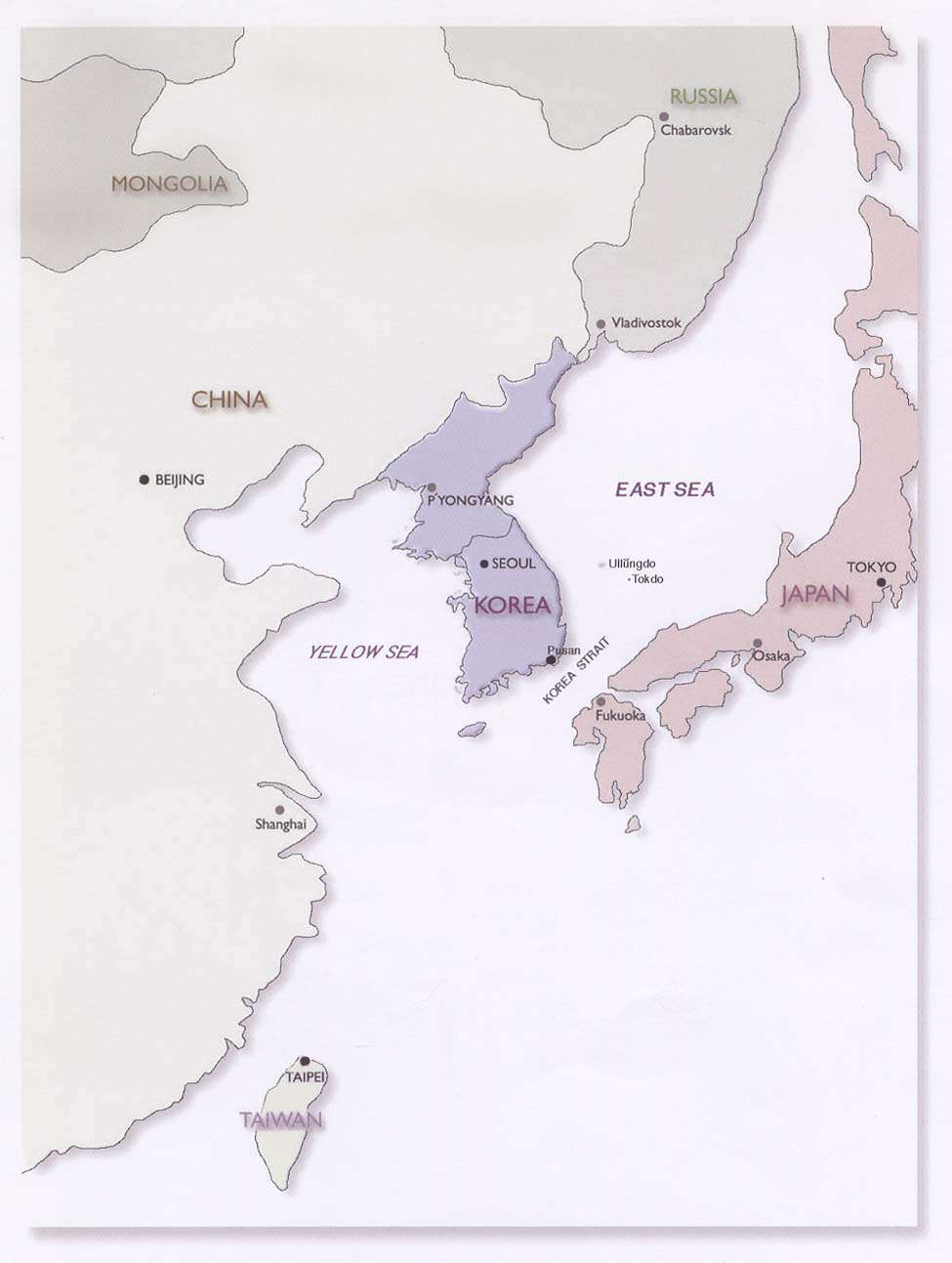
a. Geographic Domain: Asia
b. Geographic Site: East Asia
c. Geographic Impact: South Korea
10. Sub-National Factors: No
South Korea's fruit industry including apple farming has been benefited from
the market protection and the subsidies arranged by the government. In addition,
apple import in Korea is currently banned under the regulation of the National
Plant Quarantine Service[NPQS]. However, once the WTO agreement for
the market liberalization will be put into effect, the Korean government will
have to alleviate its inspection law in order to meet the conditions of the
treaty.
11. Type of Habitat: Temperate
The apple tree generally grows well in countries that have a temperate climate.
South Korea is located in the temperate areas with four distinct seasons. The
country's weather is greatly influenced by the surrounding oceans and the Asian
continent. The Asian monsoon brings South Korea "frigid air from the Arctic
in winter and warm, moisture-laden air from the South China Sea in summer"
[MEOE, South Korea]. The frigid winter temperature in South Korea is
suitable for the cultivation of apple trees that "are best adapted to areas
in which the average temperature approaches or reaches freezing during at least
two months" [MEOE, Apple].

12. Type of Measure: Import Ban [IMBAN]
13. Direct v. Indirect Impacts: Direct
The successful implementation of DDA will bring trade liberalization that would
affect the process of import-export, domestic production and consumption through
lowering prices. In addition, trade liberalization would improve the effectiveness
of the distribution of domestic resources in the long run. For example, if a
country finds more interest in auto industry compare to aviation, it would invest
more in auto industry by distributing its resources such as capital and human
resources to further develop this industrial sector. However, liberalization
would also intensify competition that may result in the dismissal of less competitive
producers thus increase unemployment. The degree of these phenomena may very
depending on member countries' economic scale, and the strength of different
economic sectors.
In the case of South Korea, the impact of trade liberalization will be considerable
because of its high dependency on international trade: 70% of its GNP is based
on transaction from exportation and importation compare to other countries.
It is expected that DDA will bring relatively positive impact to South Korea
in general by increasing substantial GDP and the overall import-export transaction.
Unfortunately, however, South Korea's agricultural sector that has relatively
low international competitiveness is expected to suffer if DDA alleviates agricultural
tariffs as well as non-tariff barrier. The inflow of cheap foreign agricultural
products including Chinese apples in this case will lead Korean farmers to reduce
their production and consequently curtail their income.
14. Relation of Trade Measure to Environmental Impact
a. Directly Related to Product: Yes [Apple]
b. Indirectly Related to Product: No
c. Not Related to Product: No
d. Related to Process: Yes [Habitat Loss]
15. Trade Product Identification: Apple
16. Economic Data
Table 3. South Korea: Amount of Apple
Production (1990-2001)
|
1990 |
1992 |
1994 |
1996 |
1998 |
2000 |
2001 |
Size of Land (1000 ha) |
48.8 |
53.0 |
52.1 |
43.9 |
34.7 |
29.1 |
26.3 |
Output (1000 ton) |
629 |
695 |
616.5 |
651.4 |
459.0 |
489 |
403 |
source: GACA
Table 4. South Korea: Average Price for
Apples (US$/ kg)
Year |
97 |
98 |
99 |
00 |
Unit Price |
1.40 |
0.89 |
0.84 |
0.78 |
source: GACA
17. Impact of Trade Restriction: High
In South Korea, the import of apples are restricted under the regulation of
the National Plant Quarantine Service. However, the country will have to liberalize
its apple market sooner or later in order to carry out the conditions under
WTO agreement. Once this happens, China will emerge as the greatest threat to
Korean apple producers.
Table 5. China: Average Price for Apple
Export (US$: kg)
Year |
97 |
98 |
99 |
00 |
Unit Price |
0.41 |
0.38 |
0.35 |
0.33 |
source: GACA
18. Industry Sector: Food
19. Exporters and Importers: Many and South Korea

20. Environmental Problem Type: Habitat Loss
In order "to protect Korean agriculture, forestry and natural environment
from exotic plant pests", the National Plant Quarantine Service has regulated
import of various foreign plants and plant products such as "seedlings,
bulbs, grains, fruits, vegetables, woods, oil seeds, spices, cut flowers, rice
straw products, mushrooms, etc" [NPQS]. Apple fruit fly, also
known as Rhagoletis pomonella or apple maggot, has been the the major concern
that leads this government agency to prohibit apple importation in Korea. Apple
maggot would cause serious damage on early-maturing kinds of apples. Eggs of
the female fly laid in apple may make the fruit distorted or dimpled. White
or yellowish worms from the eggs would emerge in the developing apples, leaving
brown trails through the fruits. In addition, small pits would be found on the
surface and mature larvae would emerge from these holes [Missouri Botanical
Garden].
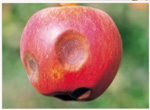
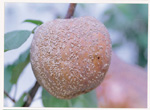
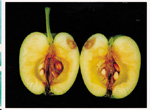
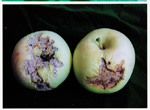
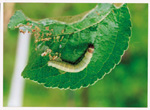
source: Chungju Apple Research Institute
21. Name, Type, and Diversity of Species
Name: Apple
Type: Deciduous Plant
Diversity: Crab apple, Jonathan apple, and Fuji apple are widely cultivated
in South Korea
22. Resource Impact and Effect: Low and Product
23. Urgency and Lifetime: Low and 10 Years
24. Substitutes: Like Products
The production costs of pears and grapes are relatively cheap compared to apples.
Therefore, these fruits can be supplied in cheaper prices to consumers. In addition,
the variety of fruits are not listed on the import ban regulated by the country's
National Plant Quarantine Service: Kiwi fruit, grapefruit and melon from USA;
citron, cherry, tomato and strawberry from Japan; blueberry from Nepal and Indonesia;
pomegranate from Iran and Uzbekistan, etc.

 VI.
Other Factors
VI.
Other Factors
25. Culture: Yes
Unlike many Western countries, apples have not been consumed in variety of
ways in Korea. Traditionally, Koreans have eaten raw apples most of the time.
However, many apple producers have started introducing a menu with the fusion
of Korean traditional foods and apples (apple kimchi, apple rice cake, apple
dumplings, and apple punch, etc) or Western style apple menu (apple salad, apple
spaghetti, apple pie, and apple cub cake, etc) in order to increase the domestic
demands for apples[ILOVEAPPLE].
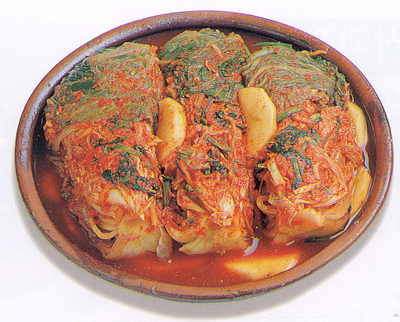
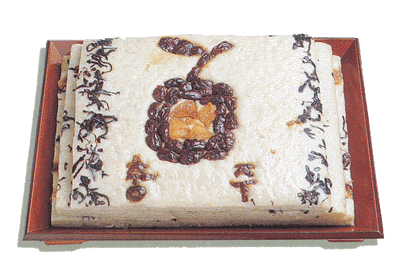

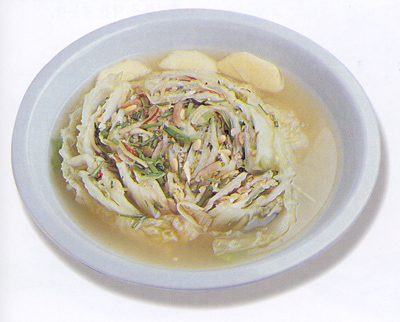
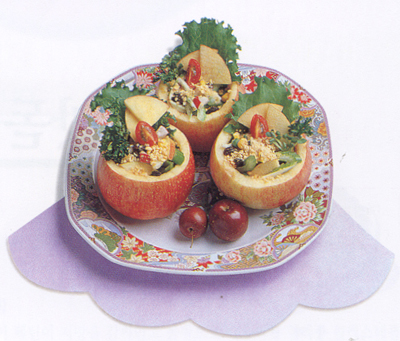
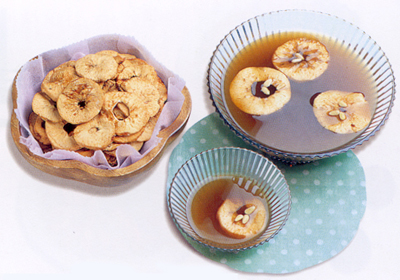

source: ILOVEAPPLE
26. Trans-Boundary Issues: Yes
27. Rights: No
28. Relevant Literature :
- Barbiza, David. "Export Apple of China's Eye Is, Er. Apples."
New York Times 4 April 2003.
- Kim, Mi-Hui. "Korea's New Vision." Korea Herald 14 June
2002.
- MacDonald, Donald Stone. The Koreans: Contemporary Politics and Society.
Boulder: Westview Press, 1996.
- Yu, Chi-Min . Yu Chi -Min's Economy Cafe. Seoul: Dolbegae, 2002.
(Korean)
- "Korea, South ," and "Apple", Microsoft
Encarta Online Encyclopedia, 2003
- Chongju Apple Research
Institute (Korean)
- Jecheon Apple Farm Incoperated (Korean)
- The Blue House/ Chongwadae
- Free Trade
Agreement : Chile and Korea
- Gilan Agricultural
Cooperative Association (Korean)
- ILOVEAPPLE (Korean)
- Ministry of Agriculture
and Forestry, ROK
- Ministry of Foreign Affairs
and Trade, ROK
- Missouri
Botanical Garden
- The National Plant Quarantine Service,
ROK
- United States Department of Agricultrue
- World
Trade Organization / Doha Declaration
1/2001


 I. Identification
I. Identification











